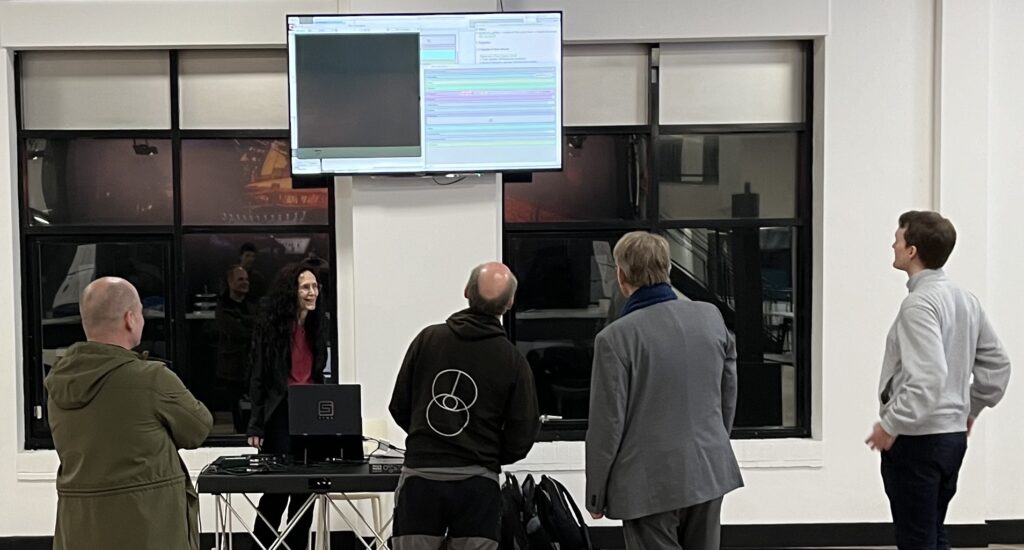Cristián Vogel is on his way to the music conservatory in Aalborg, Denmark to present a few days of composition and sound design workshops.
He writes of Kyma: “Effortless to set up on a train, wonderful I can keep working on my NEL VCS Player…”
Official organ of the Symbolic Sound Corporation
Cristián Vogel is on his way to the music conservatory in Aalborg, Denmark to present a few days of composition and sound design workshops.
He writes of Kyma: “Effortless to set up on a train, wonderful I can keep working on my NEL VCS Player…”
Composer/performer Anne La Berge was the featured artist for the 2025 SPLICE Institute — an annual Institute designed for performers and composers to study the integration of performance with electronics where she presented several performances, worked with student composers, and was invited to do an introductory session on how she uses Kyma in her work.
During the conference, she became a role model for students seeking artistic careers outside of academia.
Earlier in the summer, she was featured in the Cortona Sessions for New Music (20 July – 1 August, 2025 in Ede, Netherlands) — an educational program dedicated to the creation and performance of contemporary music, and a meeting place for emerging composers and performers seeking to collaborate, learn, grow, and create.
It’s a question at the top of everyone’s mind recently: When your current situation feels broken, should you stay and try to fix it? Or should you go somewhere else and start fresh?
 We interviewed two Kyma artists — Andrea Young, professor of composition at University of Auckland in New Zealand. And Franz Danksagmüller, professor at the Musikhochschule Lübeck (MHL) in Germany and visiting professor at the Royal Academy of Music in London.
We interviewed two Kyma artists — Andrea Young, professor of composition at University of Auckland in New Zealand. And Franz Danksagmüller, professor at the Musikhochschule Lübeck (MHL) in Germany and visiting professor at the Royal Academy of Music in London.
Recently, Franz and Andrea were each (independently) recruited to join the faculty of a different university in another country. After much consideration, Franz chose to stay in his current position, and Andrea chose to travel halfway around the world to accept a new position. What factors entered into their decisions? In the interests of anonymity, let’s refer to the two options as the Stay option and the Go option.
By augmenting traditional sample-based sound design with generative models, you gain additional parameters that you can perform to picture or control with a data stream from a model world — like a game engine. Once you have a parameterized model, you can generate completely imaginary spaces populated by hallucinatory sound-generating objects and creatures.
Thanks to Mark Ali and Matt Jefferies for capturing and editing the lecture on Generative Sound Design in Kyma presented last November by Carla Scaletti for Charlie Norton’s students at the University of West London.
Franz Danksagmüller is offering a Kyma workshop next semester at the Musikhochschule Lübeck as part of a new Master’s Program in Organ Improvisation: Creativity, Innovation, and Interdisciplinarity – a course of study offering creative, cutting-edge musicians an opportunity to develop their artistic personalities through innovative improvisation, composition, electronic instrument and controller design, creative AI for improvisation and composition, generative video and sound design, and Kyma for live electronic performances.
Recently featured on NDR news, the groundbreaking program brings the art of organ improvisation into the 21st century and introduces the organ to artists from other disciplines. The focus is on current styles and techniques and on combining the organ with contemporary trends and modern media. Students develop individual forms of expression and acquire the skills necessary to realize innovative musical and live digital media projects and collaborations.
Closely aligned with the “Sound Arts and Creative Music Technology” degree program, the new degree includes courses in:
Through a collaboration with St. Nikolai church in Hamburg, students gain access to an innovative hyper-organ, where they can learn microphone placement for processing the organ sound, handle MIDI connections and electronic platforms, and use the organ as an interface for interactive and multimedia projects. The program also maintains close partnerships with the Orgelpark in Amsterdam — renowned for its pioneering work in merging tradition and modern technology — and the experimental organ at St. Martin’s Church in Kassel —known for its quarter-tone manual, wind regulation options, and overtone registers, offering additional ways to explore contemporary improvisation techniques and soundscapes.
Thanks to close collaborations with universities and institutions in Lübeck and Hamburg, as well as partnerships with international festivals, students benefit from extensive practical experience and networking opportunities. Collaboration with students from other disciplines is particularly encouraged at MHL.
Numerous partnerships with various festivals (including the Nordic Film Days Lübeck, the largest film festival in Northern Europe) and major churches in Northern Germany provide students with the opportunity to present their work to a broader audience.
The Master’s Program in Organ Improvisation: Creativity, Innovation, and Interdisciplinarity at Musikhochschule Lübeck combines tradition with innovation and opens doors to a new direction in musical creation, positioning the organ as a central interface for artistic expression.
For more details and to find out how to apply, visit:
https://www.mh-luebeck.de/de/studium/studiengaenge/master-of-music-orgel-improvisation/
If you haven’t visited the Kyma Discord Community recently, you may want to take a look (select Discord from the Help menu in Kyma). Here are just a few of the announcements you may have missed:
• Rick Stevenson posted examples from his new RdSP — a polyphonic sample player he created that uses his Rungler to select and schedule from a pool of samples — available for download from the Kyma Community Library. Here’s one of the excerpts Rick posted as an example:
• Anne La Berge announced the release of the new album that she recorded with Tom Hamilton in January 2020 with overdubs by Suzana Lașcu in 2024.
• Lots of questions and answers in the new-to-kyma forum (reminders & refreshers for experienced Kyma users as well as quick answers for those who are just getting started on their Kyma explorations). If you run into a question, just select Discord from the Help menu to get an answer from the community of sound designers and developers.
• Rio Roye posted a clip of himself playing Ben Phenix’s cloud index divisor tool with 12 cloud indexes dividing the same high frequency pulse train.
• There was a discussion of how to create sequencers (and a reference to Bart McLean’s tutorials in Insights magazine
• Samuel Sacher invited everyone to share the titles of their favorite books on sound (in the palaver forum).
And much more! If you ever have a question or just feel like chatting with a fellow Kyma sound designer, the (international) Kyma Community is always just one menu selection away. (Alternatively you can install the Discord app on your mobile device and set up alerts so you always know what’s happening).
See you there!
At the IRCAM Forum Workshops @Seoul 6-8 November 2024, composer Steve Everett presented a talk on the compositional processes he used to create FIRST LIFE: a 75-minute mixed media performance for string quartet, live audio and motion capture video, and audience participation.
FIRST LIFE is based on work that Everett carried out at the Center of Chemical Evolution, a NSF/NASA funded project at multiple universities to examine the possibility of the building blocks of life forming in early Earth environments. He worked with stochastic data generated by Georgia Tech biochemical engineer Martha Grover and mapped them to standard compositional structures (not as a scientific sonification, but to help educate the public about the work of the center through a musical performance).
Data from IRCAM software and PyMOL were mapped to parameters of physical models of instrumental sounds in Kyma. For example, up to ten data streams generated by the formation of monomers and polymers in Grover’s lab were used to control parameters of the “Somewhat stringish” model in Kyma (such as delay rate, BowRate, position, decay, etc). Everett presented a poster about this work at the 2013 NIME Conference in Seoul, and has uploaded some videos from the premiere of First Life at Emory University.
Currently on the music composition faculty of the City University of New York (CUNY), Professor Everett is teaching a doctoral seminar on timbre in the spring (2025) semester and next fall he will co-teach a course on music and the brain with Patrizia Casaccia, director of the Neuroscience Initiative at the CUNY Advanced Science Research Center.
A highlight of this year’s Cortona Sessions for New Music will be Special Guest Artist, Anne La Berge. Known for her work blending composed and improvised music, sound art, and storytelling, Anne will be working closely with composers and will be coaching performers on improvisation with live Kyma electronics!
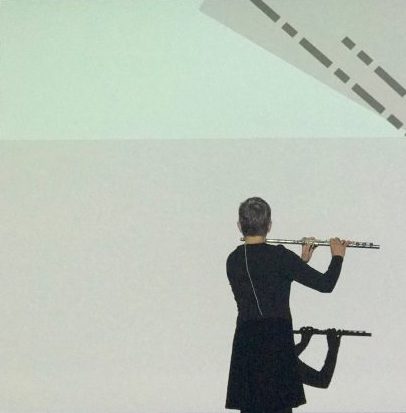
The Cortona Sessions for New Music is scheduled for 20 July – 1 August 2025 in Ede, Netherlands, and includes twelve days of intensive exploration of contemporary music, collaboration, and discussions on what it takes to make a career as a 21st-century musician.
Anne is eager to work with instrumentalists and composers looking to expand their solo or ensemble performances through live electronics, so if you or someone you know is interested in working with Anne this summer, consider applying for the 2025 Cortona Sessions!
Applications are open now (Deadline: 1 February 2025). You can apply as a Composer, a Performer, or as a Groupie (auditor). A full-tuition audio/visual fellowship is available for applicants who can provide audio/visual documentation services and/or other technological support.
At the invitation of UWL Lecturer Charlie Norton, Carla Scaletti presented a lecture/demonstration on Generative Sound Design in Kyma for students, faculty and guests at University of West London on 14 November 2024. As an unanticipated prelude, Pete Townshend (who, along with Joseph Townshend, works extensively with Kyma) welcomed the Symbolic Sound co-founders to his alma mater and invited attendees to tour the Townshend Studio following the lecture.
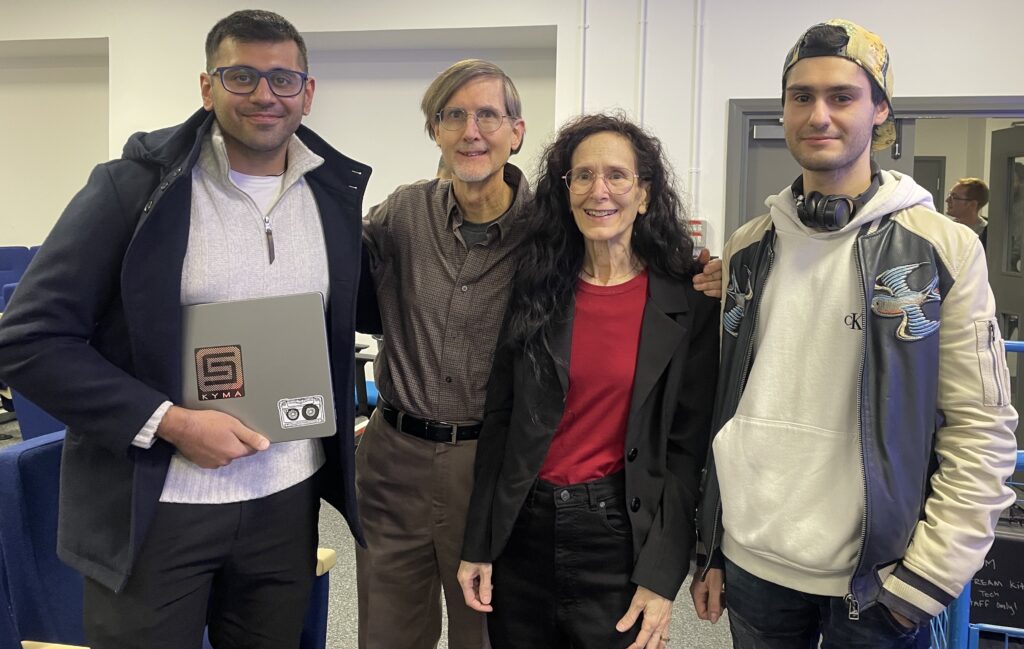

It seems that anywhere you look in the Townshend Studio, you see another rock legend. John Paul Jones (whose most recent live Kyma collaborations include Sons of Chipotle, Minibus Pimps, and Supersilent among others) recognized an old friend from across the room: a Yamaha GX-1 (1975), otherwise known as ‘The Dream Machine’ — the same model JPJ played when touring with Led Zeppelin and when recording the 1979 album “In Through The Out Door”. Yamaha’s first foray into synthesizers, only 10 were ever manufactured; it featured a ribbon controller and a keyboard that could also move laterally for vibrato. Other early adopters included ELP, Stevie Wonder and Abba.

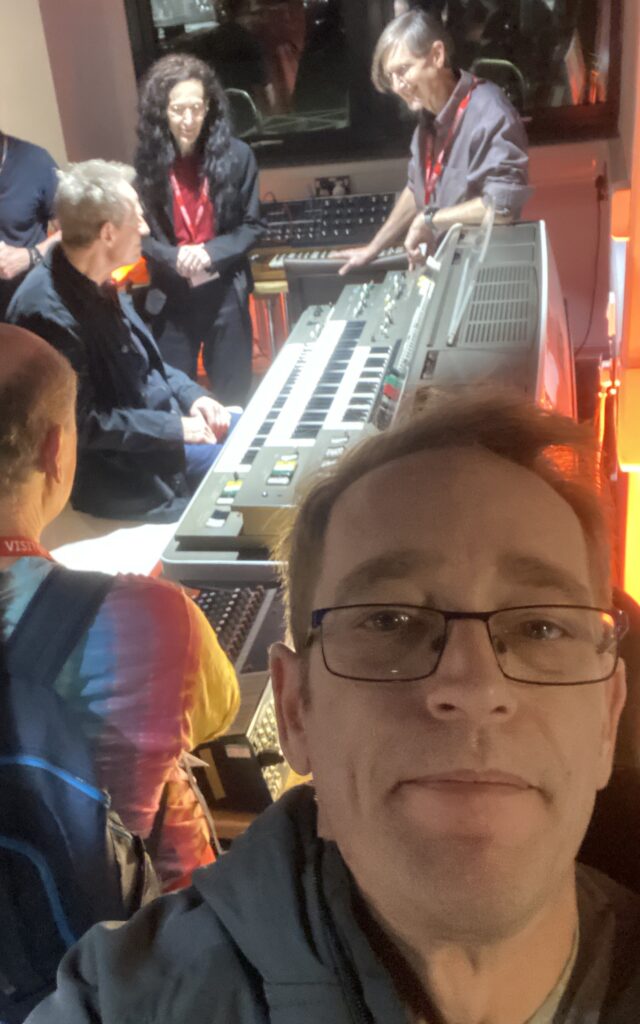
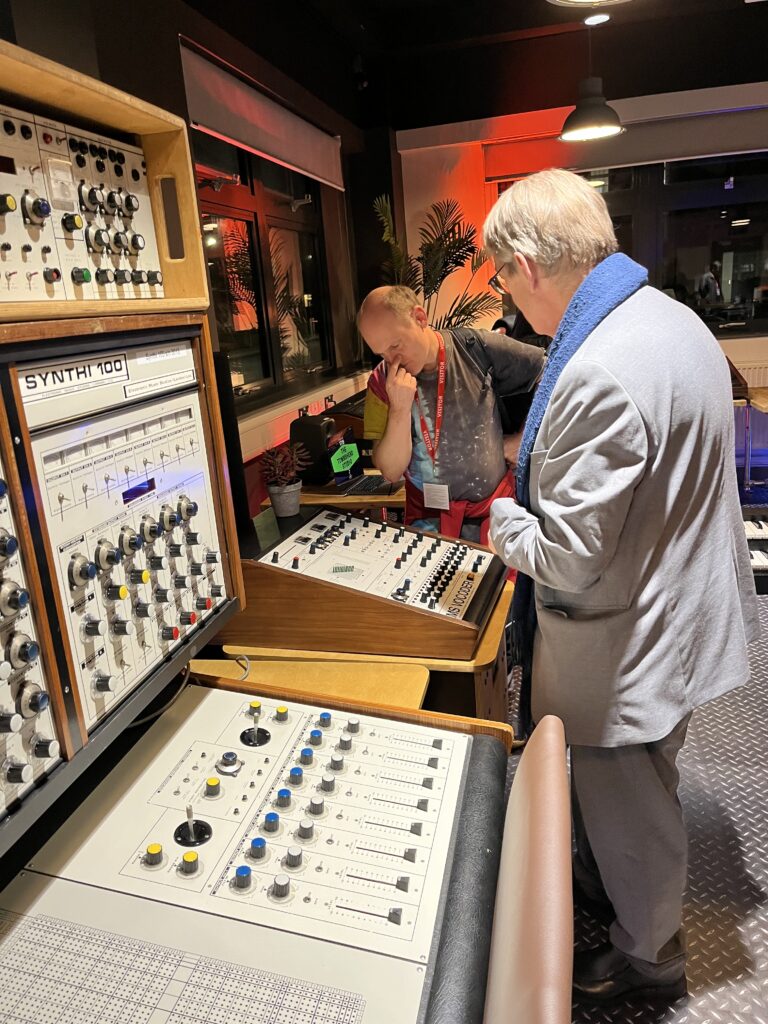
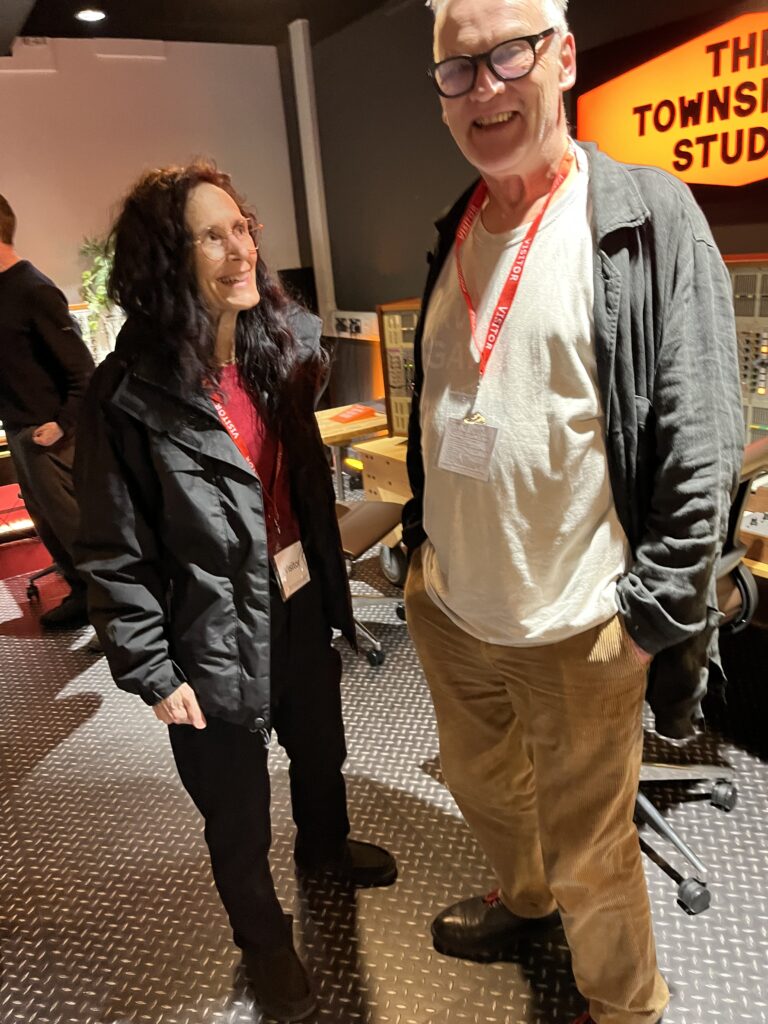
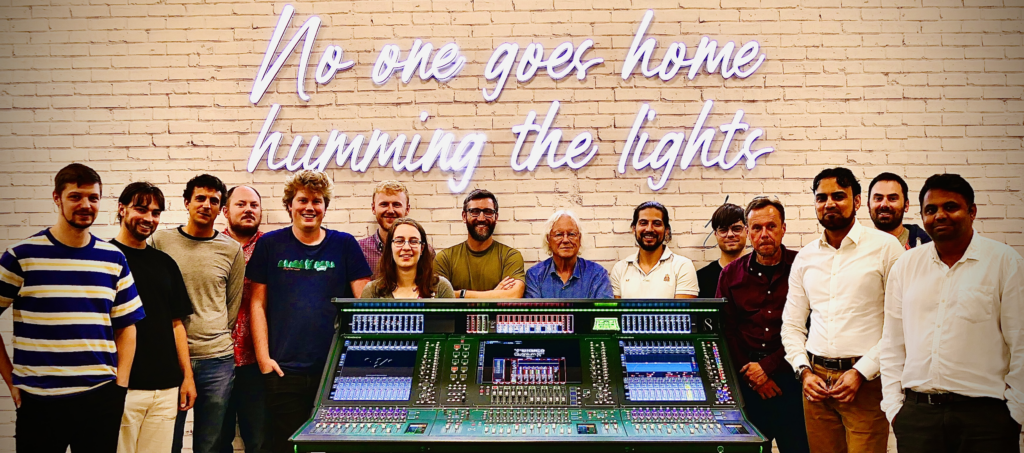
On Friday afternoon, 15 November 2024, Pete Johnston (software department) and Michael Aitchison (head of R&D) invited Carla Scaletti to present a seminar on sound synthesis for the R&D team at DiGiCo.
Following the lecture, Pete Johnston (who routinely prototypes and tests new signal processing algorithms in Kyma first before implementing them on the embedded processors in the live consoles) led the guests on a tour of DiGiCo’s testing facility and answered questions about the fully redundant, live fall-back dual consoles and the on-call 24/7 worldwide user support that DiGiCo provides for their live pro consoles.
